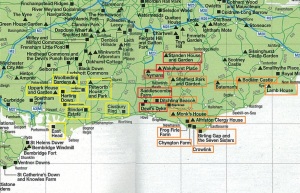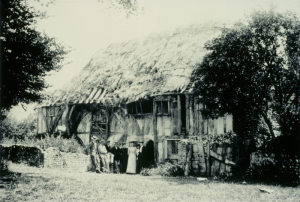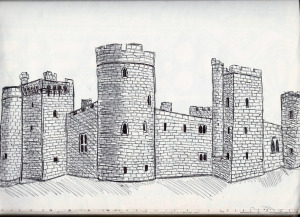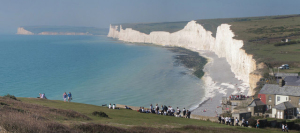Every region of the National Trust is home to a wealth of properties, all begging to be explored. Royal Oak’s Jacqueline Bascetta has done the legwork for Sussex: don’t miss out on these incredible properties on your next visit to England! Just print out this guide, pack your Royal Oak membership and you’re set! Join Now
Finishing up the post of all National Trust sites in Sussex, here’s the sites for the East. Follow along with our map by looking at the sites labeled in orange. To check out my other posts about Sussex, click here and here!
As much as I love seeing sprawling country mansions, my favorite buildings in the English countryside will always be tiny, medieval, farm cottages. The Alfriston Clergy House, built in 1350, was actually the first property to be acquired by the National Trust, for a grand sum of £10. There are some pretty amazing features and stories associated with this building. I could start with the gorgeous thatched roof which, by virtue of old photographs online, we can see was in a pretty dire state when it was purchased. SPAB (the Society for the Protection of Ancient Buildings) advised the Trust in their repairs of this collapsing property. There is a myth that an oak leaf carving in the building inspired the National Trust’s logo (and by proxy, Royal Oak’s logo!), though there is no evidence for this.
Bateman’s is a Jacobean house and the home of Rudyard Kipling from 1902-1936. The sandstone building, built for a local ironmaster became the house and office of Kipling, whose study remains in the same state he left it: filled with books, a 17th century table, writing tools, paperweight and a pipe. Also apparent in the house is Rudyard’s love for the Far East, with its collection of oriental rugs and artifacts. You can see Kipling’s Nobel Prize for literature from 1907 as well as other items from the collection (or view them here!) There’s also a 17th century watermill, with its turbine generator installed in 1902. Other highlights include a phonograph of Kipling’s poems set to music, the pets graveyard, beehives, and the alphabet necklace from Just So Stories. When your tour of the house is concluded, stroll along the lovely gardens.
Bodiam Castle fully transports the visitor who gazes upon it back to the 14th century. How could it not, with its moat, battlements, and portcullis? The ruins in the interior of the castle allow visitors to glimpse the kitchens, the well room, and even spot more gruesome features like the “murder holes.” There are characters in medieval costume, guided walks, a tea room and gift shop. For those preservation enthusiasts, this site is a Grade I listed building and a Scheduled Ancient Monument. For those movie-fanatics, you might have noticed it in Monty Python and the Holy Grail. If you want an added bonus, you check out my (extremely) simple sketch that I did of Bodiam Castle for fun one afternoon. It’s a site that definitely inspires all, even amateur artists!
Monk’s House is, despite its moniker, not a clerical dwelling. It’s actually the home of the famous novelist Virginia Woolf and her husband from 1919-1969. The house is tiny, so occasionally the number of visitors is limited, but the grounds, which include a fascinating interior and the Woolf’s prized garden, have much to offer. The Monk’s House twitter account posts gorgeous weekly garden photos which shows how extensive and creative the garden can be!
Although Sheffield Park is owned by the National Trust, the gothic country house it adjoins to is still a private residence. The house was remodeled in the 1700s by James Wyatt, while Capability Brown landscaped the garden, followed by Humphrey Repton. There are four lakes, multiple paths, wooded areas, and secluded spots to enjoy. If you’re timing your visit, try to get there on a Tuesday or Friday from 12:00-1:00 PM to enjoy the white water spectacular at the Pulham Falls, which were installed by Pulham and Son in 1882-1885.
Birling Gap and the Seven Sisters and Crowlink
The National Trust owns much of the coast and land in the Wealden District of East Sussex up to the A259 from the east of Seaford to the west of Eastbourne. This countryside includes the Birling Gap and the Seven Sisters. The Birling Gap is a coastal village, built upon the chalk cliffs. There has been evidence of Iron Age hillforts, though a lot of history has been overtaken by the sea. If you’re brave enough to take the metal staircase down to the pebbled beach and enjoy the views of the Seven Sisters Chalk Cliffs, it’s definitely advised to do it sooner than later! Due to coastal erosion, several 19th century cottages have had to be demolished over the past few years as more of the cliffs succumbs to the sea. Going for a secluded walk through Crowlink will give breathtaking views of this amazing piece of coast. The National Trust also has a shop and café at the Seven Sisters for visitors to sit and enjoy a coffee or cake.
Scenic countryside, like Black Cap, are full of hidden surprises and history. Black Cap’s hills is filled with “burial mounds, battle grounds and ancient trackways.” Walking trails over views of the south, and songbirds can be heard during a trek through the fields, woodlands and chalk paths. The National Trust offers some tips to enjoy a step-by-step route and spot flowers and wildlife.
As the highest point in East Sussex, Ditchling Beacon provides 360 degrees views. Its name is a reference to its old warning beacon, which could be seen for miles to alert villages of incoming invasions when lit.
Chyngton Farm & Frog Firle Farm in the Cuckmere Valley
Artefacts left behind from World War II can be spotted at Chyngton Farm, including anti-tank traps, pill boxes and bunkers. The National Trust also provides a step-by-step walking tour guide for Frog Firle Farm. But the true gem, in my opinion, is the absolutely stunning view of the Cuckmere River meandering through the valley.
Last on our list, but not least is the 18th century house of Henry James. The house included a detached Garden Room, used by Henry James and later E.F. Benson as a writing room, however a German bomb destroyed it in 1940. This Garden Room was recreated in 2014 for the BBC adaption of E.F. Benson’s “Mapp and Lucia.” Although this was only a temporary set, it has inspired the National Trust to fundraise to rebuild the missing room. The site includes one of the largest gardens in Rye, with many of the original species of flora. As a final piece of history, in 1726 King George I stayed at the house for three days as a result of a strong storm. Although the original homeowners, James Lamb and his wife, knew no German, and the King spoke very little English, they seemed to have still got on very well—on the first night, Mrs. Lamb gave birth to the baby boy and the King acted as his godfather at St. Mary’s Church, christening the boy George.







